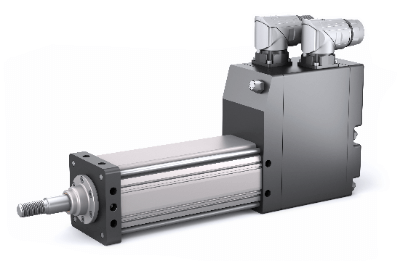What Is a Linear Servo Motor?
 A linear servo motor is an electric motor that does not have a built-in rotating shaft and is capable of linear motion for use in servo mechanisms utilized in machine control.
A linear servo motor is an electric motor that does not have a built-in rotating shaft and is capable of linear motion for use in servo mechanisms utilized in machine control.
While general motors perform rotary type motion, linear motors generally perform linear type motion. Linear motors themselves are devices for driving and propulsion widely known as linear motor cars, etc. Servomotors are motors used to control position, speed, etc. in servo mechanisms.
Until recently, rotary servo motors have been the mainstay of linear motion systems for industrial machinery and measuring instruments, but in recent years, linear servo motors, which operate by the action of the magnetic flux generated by a permanent magnet and the current flowing through a coil (Fleming’s left-hand rule), have been attracting attention.
Uses of Linear Servo Motors
Linear servo motors are used in a variety of applications. In particular, applications vary depending on the size.
1. Small Diameter (φ4 to 12 mm)
These are used in desktop-type equipment. Mainly used for observation of industrial products and biotechnology-related products. Shaft motors are required to have high resolution in fields where higher resolution images and image processing are required.
2. Medium Length (Up to Φ35mm)
This size is the most widely used in fields that require high thrust, high precision, and high speed, and is widely used for various positioning and moving parts in machine tools and semiconductor equipment.
3. Large Diameter (Up to Φ60mm)
Other applications include special machines that require large acceleration thrust.
Principle of Linear Servo Motors
The linear motion of a linear servo motor is based on the principle that a linear motor, which consists of a shaft with a magnet on its axis and a mover containing a coil, generates thrust through the action of the current flowing through the coil and the magnetic flux generated by the permanent magnet, or Fleming’s left-hand rule.
The shaft is usually a pipe made of stainless steel filled with magnets at equal intervals, and the mover consists of a three-phase coil wound around the shaft. The mover does not come into contact with the shaft, and its incorporation does not affect the thrust itself, making it easy to install. It operates by generating thrust through the action of the magnetic induction flux generated by the permanent magnet and the current flowing in the coil.
Features of shaft-based motors include high-precision positioning when high-precision linear scales are used, no backlash, and almost no cogging due to the absence of a core. Note that cogging refers to the fine vibration of the magnetic attraction between the shaft and mover in a motor that depends on the angle of rotation.
Since there are no screws, nuts, or other mechanical structures inside, high-speed motion is possible. While the accuracy of motion is excellent, the rigidity is low because the fixed side is not in contact with the moving side, making it unsuitable for heavy-duty cutting where resistance is high. It is used in equipment used to process electronic components such as semiconductors and medical parts. Its small size and simple structure are advantages when incorporated into equipment.
Other Information on Linear Servo Motors
1. Advantages of Utilizing Linear Servo Motors as Actuators
One of the requirements of today’s high-performance industrial machinery is to achieve both high-precision machining and high-speed machining. Before linear servo motors were commercialized, linear actuators used a combination of a rotary motor and a ball screw with bearings as a component to convert rotational power into linear power.
With the conventional method, it is technically difficult to achieve both higher accuracy and higher operating speed, and maintenance tends to be more frequent. Linear servo motors, however, are non-contact and have many advantages: they excel in high-speed operation, their positioning accuracy can be easily increased to high precision, and they do not require maintenance.
2. Challenges in Using Linear Servo Motors as Actuators
The challenges in applying linear servo motors to machine tools are their power density and controllability. Compared to conventional rotary motors and ball screws, linear servo motors are difficult to control, and high technology is required to ensure high output density.
Recent technological innovations by manufacturers have overcome these challenges, and linear servo motors are gradually being widely used in machine tools and industrial equipment.